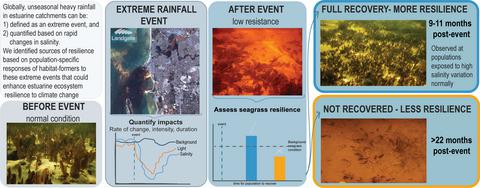Our official English website, www.x-mol.net, welcomes your
feedback! (Note: you will need to create a separate account there.)
Population-specific resilience of Halophila ovalis seagrass habitat to unseasonal rainfall, an extreme climate event in estuaries
Journal of Ecology ( IF 5.3 ) Pub Date : 2021-03-18 , DOI: 10.1111/1365-2745.13648 Chanelle L. Webster 1 , Kieryn L. Kilminster 2, 3 , Marta Sánchez Alarcón 2 , Katherine Bennett 2 , Simone Strydom 1, 4 , Sian McNamara 1 , Paul S. Lavery 1 , Kathryn M. McMahon 1
中文翻译:

卵形嗜盐海草栖息地对非季节性降雨(河口极端气候事件)的特定种群恢复能力
更新日期:2021-03-18
Journal of Ecology ( IF 5.3 ) Pub Date : 2021-03-18 , DOI: 10.1111/1365-2745.13648 Chanelle L. Webster 1 , Kieryn L. Kilminster 2, 3 , Marta Sánchez Alarcón 2 , Katherine Bennett 2 , Simone Strydom 1, 4 , Sian McNamara 1 , Paul S. Lavery 1 , Kathryn M. McMahon 1
Affiliation

|
- Extreme climate events are predicted to alter estuarine salinity gradients exposing habitat-forming species to more frequent salinity variations. The intensity and duration of these variations, rather than the mean salinity values ecosystems are exposed to, may be more important in influencing resilience but requires further investigation.
- Precipitation, including the frequency, intensity and timing of occurrence, is shifting due to climate change. A global analysis on the timing of rainfall in estuarine catchments was conducted. In 80% of the case studies, the maximum daily rainfall occurred in the dry season at least once over the 40-year period and could be classified as an extreme event.
- We selected an estuary in southwestern Australia and investigated the effects of an extreme rainfall event in 2017 resulting in an excess discharge of freshwater on seagrass Halophila ovalis. Adapting an approach applied for marine heatwaves using salinity data, we quantified metrics and characterised the event along the estuarine gradient. We assessed seagrass resilience by calculating resistance times based on the comparisons of biomass and leaf density data prior to, and during the event, and recovery times through assessment against historical condition.
- Where salinity is historically more variable, reductions in biomass were lower (higher resistance via plasticity in salinity tolerance) and meadows recovered within 9–11 months. Where salinity is historically more stable, loss of biomass was greatest (low resistance) post-event and recovery may exceed 22 months, and potentially due to the rapid decline in salinity (−3 PSU/day).
- As estuaries become more hydrologically variable, these metrics provide a baseline for retrospective and future comparisons. Our results suggest seagrass resilience to hyposalinity is population specific. This understanding enables more accurate predictions about ecological responses to climate change and identifies which populations may ‘future proof’ ecosystem resilience.
- Synthesis. Following an extreme rainfall event, we found seagrass populations that are exposed to variable salinities recovered while those from a stable salinity environment were unable to recover within the study time frame. These findings expand upon existing evidence, derived primarily from other ecosystems, that show new sources of resilience may be uncovered by accounting for between-population variation.
中文翻译:

卵形嗜盐海草栖息地对非季节性降雨(河口极端气候事件)的特定种群恢复能力
- 预计极端气候事件会改变河口盐度梯度,使栖息地形成物种暴露于更频繁的盐度变化中。这些变化的强度和持续时间,而不是生态系统所面临的平均盐度值,在影响恢复力方面可能更重要,但需要进一步调查。
- 由于气候变化,降水,包括发生的频率、强度和时间,正在发生变化。对河口集水区的降雨时间进行了全球分析。在 80% 的案例研究中,最大日降雨量在 40 年期间至少发生在旱季一次,可以归类为极端事件。
- 我们选择了澳大利亚西南部的一个河口,并调查了 2017 年极端降雨事件导致淡水过度排放对海草Halophila 椭圆藻的影响。使用盐度数据采用适用于海洋热浪的方法,我们量化了指标并描述了沿河口梯度的事件。我们根据事件发生之前和期间的生物量和叶片密度数据的比较计算抗性时间来评估海草的恢复力,并通过对历史条件的评估来评估恢复时间。
- 在历史上盐度变化更大的地方,生物量的减少较低(通过耐盐性的可塑性提高抵抗力),草甸在 9-11 个月内恢复。在盐度历史上更稳定的情况下,事件后生物量的损失最大(低阻力),恢复可能超过 22 个月,这可能是由于盐度的快速下降(-3 PSU/天)。
- 随着河口的水文变化越来越大,这些指标为回顾性和未来的比较提供了基线。我们的结果表明,海草对低盐度的适应力是特定于人群的。这种理解有助于对气候变化的生态响应进行更准确的预测,并确定哪些种群可能“面向未来”的生态系统恢复力。
- 合成。在极端降雨事件之后,我们发现暴露于可变盐度的海草种群恢复了,而来自稳定盐度环境的海草种群无法在研究时间范围内恢复。这些发现扩展了主要来自其他生态系统的现有证据,这些证据表明,可以通过解释种群之间的差异来发现新的复原力来源。











































 京公网安备 11010802027423号
京公网安备 11010802027423号